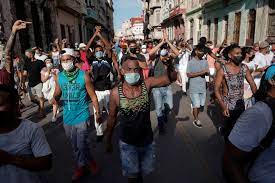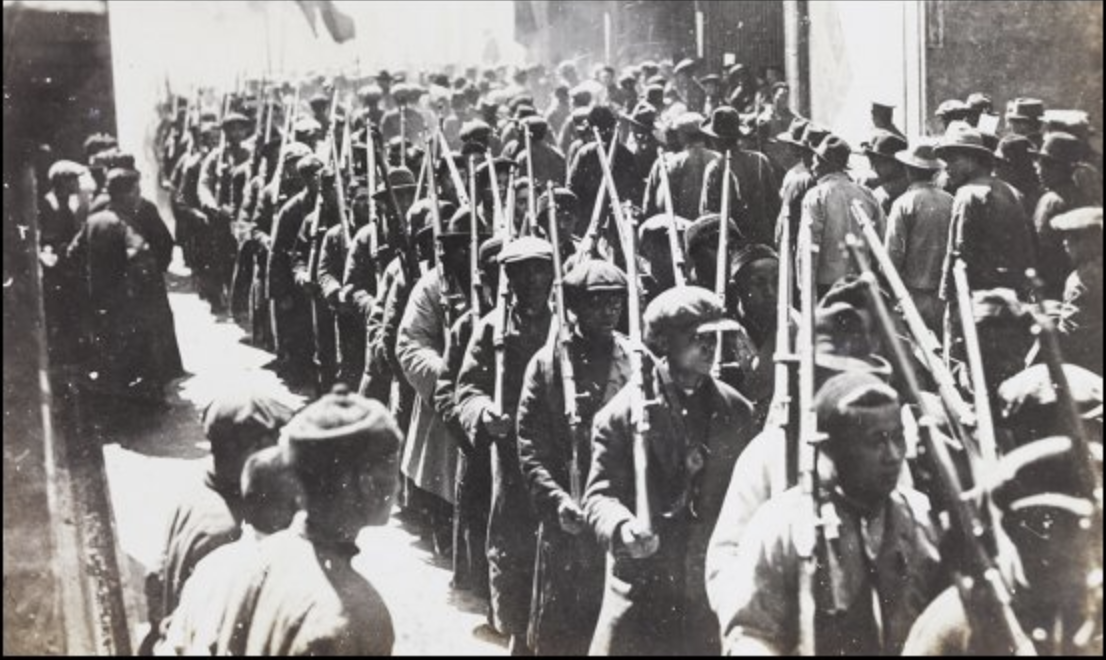
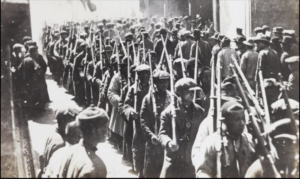
Workers’ militia marching in Shanghai, 1927
This year the Chinese Communist Party celebrated the hundredth anniversary of its founding; festivities culminated on July 1 with a mass extravaganza in Tiananmen Square addressed by Xi Jinping, Party Secretary, President, and, unofficially, dictator. In preparation, surveillance and censorship were stepped up, and the population was encouraged to report internet postings of “historical nihilism’ – i.e, any questioning of the CCP’s heroism and benevolence. Repression in China, which includes confining more than a million Uyghurs in concentration camps and stripping Hong Kong of its autonomy, is harsher now than at any time since the late 1970s.
In reality, 2021 marks the centennial of a political party that ceased to exist nearly 90 years ago. That Chinese Communist Party, founded in 1921 by revolutionary socialists inspired by democratic Marxism and the 1917 Bolshevik Revolution and based in the industrial working class of China’s cities, was essentially destroyed by Chiang Kai-shek in 1927-28. Today’s CCP was born in the early 1930s and quickly came under the control of Mao Zedong. The new CCP, deploying an army drawn from the rural poor and peasantry, fought not to bring peasants and workers to power but rather to establish the totalitarian rule of a new oligarchy — an oligarchy whose power and, in recent decades, vast wealth are based on the super-exploitation of the nation’s working people.
The absolute domination of state and society by an arrogant elite, without a shred of democracy, is strongly reminiscent of Imperial China.
THE CRUCIBLE OF NATIONALISM
The original Chinese Communist Party emerged from a prolonged democratic revolution against autocracy and foreign imperialism. The Qing dynasty had occupied the imperial throne of China since 1644. But during the nineteenth century it suffered one humiliating defeat after another, and by 1900 it was clear that the Qing’s days were numbered. After the Opium Wars with Britain and conflicts with other European powers in the 1840s and 1850s, China had to sign a whole series of “unequal treaties,” not only with Britain but also with France, Russia, the United States, and later Germany. More and more port cities had to be opened up to European and American merchants. Westerners were given “extraterritoriality”: if they committed a crime on Chinese soil they were nevertheless exempt from punishment by Chinese authorities. China was allowed to impose a tariff of only five percent on Western imports; this insignificant tax meant that the West had basically forced open Chinese markets to free trade in Western products. Within the “treaty ports,” especially Shanghai and Guangzhou (Canton), European and U.S. companies set up offices, factories and schools. Japan was another threat to China’s sovereignty. The Japanese had succeeded in launching an ambitious program of industrialization and modernization in the late nineteenth century. And like the Western powers, Japan was extending its imperialist reach.
In 1894 China and Japan, which had both been scheming to take over Korea, went to war against each other. The Sino-Japanese War was brief. Within a few months, China had been soundly defeated on land and sea. In the Treaty of Shimonoseki in 1895, Japan forced the Chinese to give up the island of Taiwan and the Liaodong Peninsula in Manchuria; China also had to pay an immense indemnity. The loss of the Sino-Japanese War was a painful blow to Chinese pride. Japan was a small country, and the Chinese had always dismissed its inhabitants as “island barbarians” and “dwarf bandits” (Japanese tended to be shorter in stature than Chinese).
Now began a “scramble for China” among the European powers. Each of them, fearing that the Qing was on the verge of total collapse, and worried that its rivals might take advantage by grabbing more than itself, rushed to carve out a “sphere of influence” in some part of China, an area where it would be the acknowledged, though unofficial, boss. Japan, which the Europeans saw as an upstart, had to be reined in, so it was forced it to give up control of the Liaodong Peninsula in favor of Russia; Russia acquired the port of Dalian on the peninsula’s southern tip and the nearby naval base of Port Arthur. Germany grabbed a naval base on the Shandong Peninsula, while Britain staked out Shanghai and the Yangzi Valley as its sphere of influence and France claimed three southern provinces, including China’s second-largest city, the port of Guangzhou.
Foreigners now received the right to set up factories and mines in China employing Chinese labor. Within their concessions they maintained their own police forces; troops and gunboats were near at hand, to be used against the Chinese whenever foreigners saw fit. In the coastal cities, almost everything was run by the foreigners – industries like cloth, cigarettes, matches, soap, flour, but also services such as gas, water, electricity and trolley cars. Their arrogance knew no bounds. The existence of a sign in a Shanghai park reading “No Dogs or Chinese Allowed” is apparently a legend, but Chinese were, like dogs, banned from parks in the foreign settlements.
With China rapidly turning into a kind of international colony, some elements in the imperial government sought reforms, chiefly the creation of a new educational system, with a national university and technical and military schools. The most radical reformers envisioned transforming China into a constitutional monarchy, with elections and a parliament. But the real power behind the throne, the Dowager Empress Cixi, along with most of the scholar-official elite, opposed reform. Instead, Cixi threw her support to a growing anti-foreign movement among the common people led by a secret, anti-Christian martial arts society called the Righteous and Harmonious Fists – foreigners called them “Boxers.” In July 1900 Cixi declared war on Britain, Germany, France, Japan, the United States, Italy, Belgium, Holland, and Austria-Hungary. Boxers killed every missionary they could get their hands on, and in Beijing they laid siege to the foreign embassies. A military force organized by the Western powers and Japan marched to the capital, slaughtered the Boxers, and plundered the city.
The Boxer Rebellion was the final blow to the Qing. It was an immense popular explosion of resistance to foreign domination. But its goal was the restoration of the old regime, turning everything back to the way it was before the imperialists arrived – that is, reconstituting the very society that had succumbed so easily to imperialist aggression. Clearly, that was a dead end. From now on, resistance to the West would take a different form.
Nationalists, especially students who had gone overseas to study, now became revolutionaries, joining secret societies dedicated to overthrowing the Qing. They regarded the dynasty as yet another group of barbarian foreigners – Manchus – who were exploiting and oppressing China. Progress would be impossible without the removal of the Qing.
THE REVOLUTION OF 1911
The largest number of students went to study in Japan. Despite the Sino-Japanese War, many progressive Chinese had looked to Japan for inspiration. Especially after the Japanese trounced Russia in the Russo-Japanese War of 1905, Japan was admired by liberals and modernizers throughout Asia. After 1905 a new self-confidence and determination swept the far-flung anti-Qing movement: students living abroad, members of the Chinese émigré community in Southeast Asia (who substantially financed the movement), young army officers in China who had been trained by foreign military instructors, and an older generation of revolutionaries. Among the latter was Sun Yat-sen.
Sun came from a peasant family near Guangzhou. He had studied at an Episcopalian mission school in Hawaii, learned English and converted to Christianity. Unlike the earlier reformers, he did not come from a privileged background, and he was entirely Western-educated. Sun began his career as a doctor, practicing in the Portuguese colony of Macao near Hong Kong. Soon, however, he was devoting all his time to working against the Qing. He started several secret societies and made several unsuccessful attempts at revolution. In 1895 Sun organized 3,000 revolutionaries to march on Guangzhou, but the plot was discovered before they could set out and Sun had to flee to Japan.
In exile, he formulated his political philosophy. One of Sun’s chief themes was what he called the Three Principles of the People: nationalism, democracy and social justice. “Nationalism” meant freeing China from foreign domination. As for “democracy,” Sun believed the Chinese were not ready for representative government; there would have to be a period of “tutelage” by qualified leaders, a benevolent dictatorship that would educate the Chinese people to be responsible citizens. By “social justice,” Sun meant economic development and land reform. Land would be distributed to the poor, and the government would borrow capital from the West to invest in building up Chinese industry.
In 1905 Sun brought together several secret societies based in Japan and formed the Tongmeng hui – the Revolutionary Alliance. Meanwhile, the Qing was making last-gasp attempts to stay in power by liberalizing China. There was great relief when the Empress Dowager died in 1908. Her young nephew, the Emperor, followed her to the grave one day later and was succeeded by a two-year-old, Puyi. In the following year, provincial assemblies met throughout China to lay the basis for a constitution. These quickly became filled with anti-Qing agitation, however. In the fall of 1911, the assembly of the province of Sichuan, meeting in the town of Wuchang, voted to break away from the imperial government in Beijing. On October 10, a soldier in Wuchang shot and killed his commanding officer, giving the signal for other soldiers to take over the town. The Chinese Revolution of 1911 had begun.
As a revolution, it was fairly bloodless – the imperial government and its few remaining supporters collapsed with barely a whimper. Soon after the events in Wuchang, revolutionary societies like the Tongmeng hui began to seize control of city after city. Within two weeks, assemblies in 15 provinces had declared their independence. On Jan.1, 1912, Sun Yat-sen took office as the first president of the Chinese Republic, and on February 12, Emperor Puyi, by now all of six years old, abdicated, bringing to a close the 268-year reign of the Qing dynasty.
The Tongmeng hui was renamed the Guomindang (GMD) – the Nationalist Party – dedicated to Sun Yat-sen’s Three Principles of the People. But supporters of the Revolution included powerful landlords and generals, who had no interest in democracy and social justice and regarded Sun and his fellow revolutionary intellectuals with deep suspicion. Sun himself worried that the new Republic would not survive without strong military backing. Consequently, he agreed to turn over the presidency to a general, Yuan Shikai, who had been a leading official under the Qing. Yuan was the head of the biggest army in China, and Sun hoped he would use it to unify the country. So on Feb. 14, 1912, Yuan succeeded Sun as president.
Within a year, however, Yuan began to assume dictatorial powers. He dissolved the Guomindang and forced its members underground. Only a year after leading a successful revolution, Sun Yat-sen found himself once again a fugitive heading a secret revolutionary society. The Revolution had deposed the Qing, but it had not brought China any closer to democracy. Foreign imperialism still held the country in a tight grip. The mass of people, the peasants and urban workers, had not participated in the Revolution at all. Their lives only got worse.
In 1915 Yuan went so far as to abolish the Republic and declare himself emperor. Yuan was so unpopular, though, that he “abdicated” as emperor a year later, restored the Republic and resumed the presidency. Later that year he died.
After Yuan’s death, all central authority disappeared. Beijing came under the control of another general, Duan Qirui. Because he held the capital city, Duan was treated as China’s ruler by foreign governments, but he was unable to extend his authority far beyond Beijing itself. For the next ten years, China was divided up into dozens of separate regions, each controlled by men who commanded their own armies. These were the warlords. Duan was really just one warlord among many.
Unlike the generals in the imperial army, most of the warlords were not trained in Confucian values and had few ties to the old scholar-official class. Instead, they had acquired power through sheer ruthlessness. Acting like gangsters, they simply looted the provinces they controlled. Their armies, consisting for the most part of young peasant men escaping starvation, rampaged through the countryside, robbing, raping and terrorizing the population. Warlord rule was a nightmare, especially for China’s wretchedly poor peasantry.
THE MAY FOURTH MOVEMENT
Despite the weakness of the Beijing government, the Allies wanted China to join their side in World War I. A year into the War, Japan had seized Germany’s coastal possessions on the Shandong Peninsula, east of Beijing. After receiving a vague promise that Britain and France would make sure Shandong was restored after the fighting ended, Duan Qirui dutifully declared war on the Central Powers in August 1917. China had been cynically deceived, however. Earlier, the French and British had signed a secret treaty with the Japanese promising that Shandong would remain theirs once Germany was defeated. The Chinese did not know this, of course. And they were encouraged by Woodrow Wilson’s Fourteen Points to believe that the Allies really would respect China’s right to self-determination. They were to be cruelly disappointed.
At the Paris Peace Conference in 1919, the existence of the secret treaty was revealed; Shandong would not be returned to China after all. The Chinese delegates were stunned (even they did not realize that Duan Qirui had himself agreed to surrender Shandong, in return for a large Japanese loan to his regime.) Back in China, there was a wave of revulsion against foreign imperialism.
Around noon on May 4, 1919, thousands of students from Beijing’s high schools and colleges assembled in front of the Tiananmen Gate in the heart of the city. After listening to speeches, they adopted a resolution: “Today we swear two solemn oaths with our fellow countrymen: One, China’s territory may be conquered but it cannot be given away; two, the Chinese people may be massacred but they will not surrender.” The students than paraded silently through the streets of Beijing before masses of onlookers, many of whom wept at the sight of boys and girls, some as young as 13, marching for China’s honor. Eventually the demonstrators reached the home of one of those government officials who was considered pro-Japanese. The official’s house was attacked and systematically destroyed. Demonstrations quickly spread to other cities. In Beijing and elsewhere, the students were supported by merchants, who closed their shops, and by factory workers, who went on strike.
The May Fourth Movement, as it came to be known, marked a political awakening for China. But even before 1919, a new intellectual ferment had been growing among circles of educated Chinese, especially at institutions of higher education. In the treaty ports, European, American and Chinese Christians had set up colleges, many of which were financed by wealthy Westerners, such as the Rockefeller family. But the most important intellectual center was Beijing University. There, professors and students enjoyed the freedom to question traditional ideas and customs and to investigate the most modern and radical philosophies imported from the West.
One of the University’s deans was a remarkable man, Chen Duxiu. Chen had studied in France; he opposed Confucianism and was an enthusiastic proponent of science and democracy. Soon after the overthrow of the Qing, Chen and other Western-educated intellectuals began calling for a “New Culture” for China. They detested China’s stifling traditional family system, arguing for individual freedom, including freedom for women. Against filial piety, absolute obedience to one’s parents, arranged marriages and so on, they advocated the right to break out of the confines of the family, make one’s own way in the world, and love whomever one chooses.
Since 1915, Chen had edited a widely read magazine, New Youth. Along with the philosopher and literary historian Hu Shi, he urged writers to use everyday Chinese speech rather than the difficult classical literary language that had always been employed by the scholar-officials. Progress for China required the spread of education, and this was possible only if texts were written in the language of the people, which would be much easier for all to learn to read and write. Chen himself translated numerous European and American works of philosophy and history, as well as novels.
But the influence of New Youth came primarily from its attack on Confucianism and its call for revolutionary change. In the magazine’s first issue, Chen issued a ringing manifesto:
“We must discard our old ways. We must merge the ideas of the great thinkers of history, old and new, with our own experience, build up new ideas in politics, morality and economic life… Our ideal society is honest, progressive, positive, free, egalitarian, creative, beautiful, good, peaceful, cooperative, toilsome, but happy for the many. We look for the world that is false, conservative, negative, restricted, inequitable, hidebound, ugly, evil, war-torn, cruel, indolent, miserable for the many and felicitous for the few, to crumble until it disappears from sight… I hope those of you who are young will be self-conscious and that you will struggle… Why do I think you should struggle? Because it is necessary for you to use all the intelligence you have to get rid of those who are decaying, who have lost their youth. Regard them as enemies and beasts; do not be influenced by them, do not associate with them.”
The impact of these lines was electrifying. New Youth was eagerly read by students in every school and college in China. One of them later recalled: “It came to us like a clap of thunder which awakened us in the midst of a restless dream.” Chen urged educated youth not to seek lucrative careers but instead place themselves at the service of China’s suffering masses. And the proponents of the New Culture passionately believed that the first step toward ending China’s suffering was to free the country from bondage to foreign imperialism.
THE REVIVAL OF THE GUOMINDANG AND THE BIRTH OF THE CHINESE COMMUNIST PARTY
These were the seeds that came to fruition in the May Fourth Movement. The exciting events of 1919, however, almost bypassed Sun Yat-sen and the Guomindang. Shunted aside soon after the Revolution of 1911, Sun had spent the intervening years vainly attempting a political comeback. By the time the May Fourth Movement broke out, the GMD had almost disintegrated. Sun, though he detested warlordism, had himself become dependent on the warlord who controlled the city of Guangzhou. There he was allowed to establish a Nationalist “government,” but it was not recognized by any other countries, all of which preferred to deal with the Duan Qirui’s regime in Beijing.
Neither the GMD, which was a loose association of intellectuals, army officers, urban professionals and businessmen, nor Sun’s political philosophy were adapted to the new mood of militant anti-imperialism and mass action in the streets. Sun was a lifelong conspirator, who assumed that change would be brought about by small bands of dedicated men with the help of the military. His Three Principles of the People may have inspired the overthrow of the Qing, but in the aftermath of the Russian Revolution, China’s humiliation at Versailles and the growing popularity of democracy and socialism, they seemed vague and somewhat outmoded to China’s young revolutionaries.
Sun’s principle of Nationalism did not call for the expulsion of the imperialists, but instead envisaged cooperation between China and the Great Powers to develop the country’s resources to the mutual advantage of all. Many of the new radicals, convinced that the imperialists wanted only to exploit, not develop, China’s economy, considered this idea extremely naïve.* Sun had a complex scheme for providing additional land to poor peasants, but at the same time he reassured big landowners that their holdings would not be jeopardized. Though he sometimes called himself a “socialist,” Sun vehemently rejected Marxism and class struggle and was reluctant to draw the masses into political activity.
Nevertheless, Sun was still a legendary figure who commanded great respect. The May Fourth Movement did bring him and the GMD out of isolation. Sun spoke at student rallies, and in Guangzhou he began making contact with the emerging labor movement.
China’s urban working class was growing fast. The First World War temporarily interrupted the flow of Western imports, allowing new native industries to spring up in the cities alongside the many foreign-owned concerns. Factories started by Chinese capitalists began turning out cotton textiles, flour, cigarettes, matches, paper and other products for domestic consumption. Other plants manufactured the machines, such as looms, that were needed to produce these consumer goods. The demand for factory workers lured millions of peasants to the cities. The population of Shanghai, China’s largest city, doubled between 1910 and 1927, reaching 2.6 million.
The center of Shanghai was a bustling downtown, with big modern buildings, department stores and banks. And in the “international settlement” foreigners lived in mansions on tree-lined streets. But in the industrial districts of Shanghai and other cities conditions were appalling.
“Some of the match factories and carpet factories, the ceramics and glass works and the old style silk and cotton factories could well have served as inspiration for even Dante’s description of the infernal regions. Pale, sickly creatures move around there in almost total darkness, amidst indescribable filth, and breathing an atmosphere that is insupportable to anyone coming in from the outside. At 10:00 at night, or sometimes even later, they are still at work, and the feeble light of a few oil lamps lends the factories a still more sinister aspect. A few breaks are taken to snatch some food while still at work, or to eat a meal in a courtyard covered with excrement and filth of all kinds. When the time to stop work finally comes, these miserable creatures doss down [bed down] in any place they can find – the lucky ones on bales of waste material, or in the attics if there are any, and the rest on the workshop floor, like chained dogs.”
Mercilessly exploited, with no legal rights, Chinese workers nevertheless started organizing unions and waging strikes.
In Guangzhou and Hong Kong, where it was allowed to function legally, the GMD supported the workers and tried to help them organize. In all of China’s cities, students and intellectuals took an interest in the problems that workers faced and were inspired by their fighting spirit. The turn towards the working class generated an interest in socialism, and study groups were formed to read and discuss the writings of European Marxists.
Russia’s Bolshevik Revolution had a tremendous impact. Even non-socialist Chinese were impressed by the Bolsheviks’ renunciation of secret treaties and imperialism, and by the fact that the Soviet Union was the only major country that offered to treat China as an equal. Those Chinese who were drawn to socialism saw Russia as a model: even though it was a relatively poor country with a vast peasant majority, like China, the Bolsheviks had led the working class in a successful revolution. There seemed to be no reason why Chinese revolutionaries could not do likewise.
But Lenin did not think the working classes in China and other colonial and semi-colonial countries were strong enough to carry out socialist revolutions on their own. He did believe, however, that revolutions against foreign domination, even if led by middle-class nationalists like Sun Yat-sen and the GMD, would weaken imperialism and thus make it easier for workers in the advanced capitalist countries to overthrow their own capitalist rulers. And in these anti-imperialist revolutions, the workers of the colonial countries, led by Communist parties, could play a crucial role.
So, in 1921 agents of the Comintern were sent into China to help organize a Communist group. Chief among them was a Dutch Marxist, Henk Sneevliet, who had already played a key role in founding Communist parties in the Netherlands and the Dutch East Indies – modern day Indonesia. In July, 12 Chinese men, members of several Marxist societies, plus Sneevliet, met secretly in an empty girl’s school in Shanghai’s French concession – the students and faculty were away on summer vacation. Halfway through the four-day long meeting the French police got wind of it, and the men were forced to scatter. They reconvened at a lake in the countryside, where they rented a boat and pretended to be nature lovers out for a picnic. From this inauspicious gathering, the Chinese Communist Party (CCP) was formed. Although it had only 50 members to begin with, the CCP was led by two very influential personalities: Chen Duxiu and Li Dazhao, the head librarian at Beijing University. One of the first things the party did was to plunge into union organizing. As the Chinese labor movement grew, the CCP recruited thousands of workers, including much of the leadership of the new unions.
NATIONALISTS AND COMMUNISTS FORM A UNITED FRONT
Lenin believed the socialist revolution would spread from Russia first to Europe, not to Asia. But China, and other Asian countries, would be an important part of the worldwide revolutionary process. The CCP, under Bolshevik guidance, proclaimed its goal to be “democratic revolution” against imperialism and the warlords. This revolution would have to be led by the Chinese bourgeoisie, spurred on by the workers. The bourgeoisie, in turn, would be led by the GMD, and the working class by the CCP. Lenin insisted that the two groups should be allied, but separate. It was essential that the CCP maintain its independence: that way, the party would be better able to prevent the bourgeoisie from betraying the democratic revolution, and, once China was united and independent, it would be in a strong position to usher in the second stage – a socialist revolution against the Chinese bourgeoisie and landlords, supported by the workers of the advanced industrial nations.
The trouble was, the Guomindang seemed ill-equipped to lead a democratic revolution. It was poorly organized, riddled with corruption and lacking in any significant numbers of supporters outside Guangzhou. In order for the GMD to play the role foreseen by Bolsheviks, it would need to be transformed into a disciplined, well-organized mass party, with hundreds of thousands of members. Sun Yat-sen, old conspirator though he was, finally agreed too that this had to be done. So, despite his mistrust of Communism, Sun gladly accepted Russian help. The Soviet government sent a Russian adviser to Sun’s headquarters in Guangzhou, Mikhail Borodin, who, in 1923, reorganized the GMD from top to bottom. Borodin also set up a military academy, Whampoa, near Guangzhou, to train Chinese officers and build up a Nationalist army – without which Sun and the GMD could not hope to defeat the warlords and unify China.
A select group of Chinese military leaders was sent to the Soviet Union to receive their initial training. This group included an extremely ambitious young officer named Chiang Kai-shek. Chiang was a devoted follower of Sun. Upon his return to China, he took charge of the Whampoa Academy along with a staff of Russian military experts. Chiang merely pretended to go along with the Soviets, however; in reality, he hated Communism. Actually, Chiang was much more of an anti-Communist than Sun Yat-sen, but because the Soviets were useful, he kept his feelings to himself.
By 1923, when the GMD began to work with the Soviet Union, Lenin had effectively retired because of ill health, and the Troika – Zinoviev, Kamenev and Stalin – had come to the forefront in Moscow. Now Comintern policy toward the Chinese Communist Party underwent a significant shift. CCP members were directed not just to work in alliance with the Guomindang, but actually to join it. This created a confusing situation: Chinese Communists were now members of both their own party, a revolutionary Marxist organization, and the GMD, an anti-Marxist, nationalist organization led by middle class men and army officers. The CCP represented the workers, while the leaders of the GMD were in many cases the very people who owned the factories in which the workers were exploited and commanded the troops that shot down the workers when they protested their miserable conditions. Moreover, Sun Yat-sen had secured a promise from the Soviet leaders that Communists would function loyally within the GMD: they would not challenge the leadership and they would not try to recruit other GMD members to join the CCP.
The idea of a “United Front” between Communists and non-Communists was not new. In Germany, the Comintern had called for a United Front between the Communist Party (KPD) and the Social-Democrats (SPD). But that was different. The SPD was anti-revolutionary, but it was a working-class organization – unlike the Guomindang. Also, KPD members were never supposed to join the SPD and submit to its leaders. The Comintern’s China policy, we shall see, was a recipe for disaster.
THE REVOLUTION OF 1925-1927
Although Sun Yat-sen, with Soviet help, had transformed the Guomindang into a tightly disciplined mass organization, he did not expect to unify China through revolution. Sun concentrated instead on strengthening the Nationalist Army in preparation for a major military offensive against hostile warlords, while trying to win over other warlords through negotiations. In 1925 he journeyed to Beijing for talks with Feng Yuxiang, a warlord who had taken control of the capital. Known as the “Christian General,” Feng was a strong but eccentric character who was famous for such antics as “baptizing” his troops with a fire-hose. En route, Sun was discovered to have an advanced case of liver cancer, and on March 15 he died in Beijing.
On his deathbed, Sun sent a message to Soviet leaders expressing “the hope that soon will come the day when the USSR will greet a great, free China as a friend and ally, and that in the great battle for liberating the enslaved peoples of the world both allies will advance to victory hand in hand.” But these sentiments by no means reflected the views of all the Guomindang leaders, and Sun’s death set off a power struggle within the party. Sun’s chosen successor was Wang Jingwei, who had stood side by side with him since his earliest revolutionary conspiracies. But Chiang Kai-shek was eager to assume the leadership himself. Around the two, a left and a right wing began to coalesce. The Left, around Wang Jingwei, was in favor of maintaining the United Front with the CCP and friendly relations with the Soviet Union. Chiang’s supporters constituted the GMD Right. At the center of this faction was a circle of conservative businessmen who called themselves the Western Hills Group – named after the place outside Beijing where Sun Yat-sen was buried. They were dead set against the United Front with the CCP and even wanted Communists to be expelled from the GMD. Privately, Chiang had close ties to these men, but publicly he was careful not to endorse their demands. In any case, his main power base was not among the politicians of the GMD, but among his fellow officers at the Whampoa Military Academy.
The role of the Communists themselves in this factional conflict was ambiguous. While aligning themselves with the Guomindang Left, the Soviet leaders, back in Moscow, were anxious to maintain good relations with Chiang Kai-shek. They preferred to think of Chiang as a “moderate” rather than part of the GMD Right. Stalin was already emerging as the most powerful figure, and his inclinations were increasingly opposed to revolution. His vision of “socialism in one country” required only that neighboring countries, like China, not pose a threat to the Soviet Union. If Chiang Kai-shek were to become ruler of all of China, he might be a solid ally, especially if he achieved power with Russian help. To Stalin, the idea of a revolutionary democracy on Russia’s border, run by workers and peasants, on the other hand, was anathema.
Shortly after Sun’s death in 1925 a great movement against foreign imperialism erupted in central and southern China. The movement began among the workers of Shanghai, after a couple of union activists were killed in a Japanese-owned factory. Protest demonstrations broke out on May 30. Police in the international settlement fired on the demonstrators, and in response the CCP called a general strike against all foreign-owned companies. The strike was massively supported by the Shanghai working class, as well as by students and shop-owners, and it quickly spread to Guangzhou and Hong Kong. For the first time, foreigners in their settlements felt profoundly threatened. Their businesses in Shanghai, Guangzhou and Hong Kong came to a standstill. Even the servants in their mansions walked out. Moreover, the strikes soon spread to Chinese-owned factories and businesses as well. In Guangzhou and Hong Kong many workers stayed on strike for more than a year – an incredible feat of endurance for people with almost no resources to fall back on. Viciously attacked by troops and police, the workers fought back and held their ground, giving the lie to the stereotype of cowering, docile Chinese “coolies.”
This upheaval alarmed not only the foreigners. It also threw a fright into the more conservative Chinese Nationalists, especially those who were capitalists and landlords. Business owners were obviously horrified when the workers started targeting their factories as well as foreign-owned plants. In rural areas near the big cities, poor peasants had also joined in the struggle, demanding reductions in the exorbitant rents they were forced to pay to landlords. Plus, the Guomindang Right was extremely concerned that all the strikes, demonstrations and peasant agitation were strengthening the Communists, which was certainly true. Membership in the CCP had ballooned to 10,000. Workers streamed into the labor unions, most of them controlled by the CCP: by the end of 1925 they had around 1.2 million members. In Guangzhou, the Left was in control of the Guomindang.
It seemed that China, or at least a large part of it, was on the verge of revolution – a revolution that might finally complete the work of 1911, by unifying the country and freeing it from foreign domination. The leadership of the Soviet Union now turned its full attention to China. But in Moscow a debate broke out over what course the Chinese revolution should take. On the one hand, Stalin and his supporters, who controlled the Comintern, wanted to maintain the United Front of the GMD and the CCP at all costs. It was clear to them that the Chinese workers and peasants must be restrained from going too far; if the masses were not held back, the Chinese bourgeoisie would turn away and thus divide and weaken the anti-imperialist forces. On the other side was Trotsky, who argued that the Chinese bourgeoisie, like the Russian bourgeoisie in 1905 and 1917, was treacherous and cowardly; only the workers and peasants could carry out a successful revolution, and to do that they must have a cause worth fighting for. Stalin and company were acting like latter-day Mensheviks, he warned, and the result would be ruinous for the Chinese revolution:
“The victory over foreign imperialism can only be won by means of the toilers of town and country driving it out of China. For this the masses must really rise millions strong. They cannot rise under the bare slogan of national liberation, but only in direct struggle against the big landlords, the military satraps [warlords], the usurers, the capitalist brigands.”
In China, the leaders of the CCP, men such as Chen Duxiu, had always been uncomfortable with the United Front strategy. Now they were alarmed by Chiang’s increasingly obvious counterrevolutionary tendencies. But Borodin, who was very close to Stalin, dismissed their concerns.
Meanwhile, Western governments were so concerned that they began making overtures to China’s wealthy elite. Chinese businessmen received invitations to the foreign settlements for private discussions about how to deal with the Communist threat. Conservative Nationalist leaders were promised that if the Communists were crushed with severity, the Western powers would relinquish their special privileges, such as extraterritoriality and control over China’s tariffs. Chiang Kai-shek was aware of these negotiations, but in public he spoke only of maintaining the United Front against the imperialists, while carefully strengthening his power base at Whampoa.
In March 1926, Chiang Kai-shek showed his true colors. To check the growing influence of the CCP at Guomindang headquarters in Guangzhou, he carried out a surprise coup: Communist officers at Whampoa were arrested, as were the CCP leaders in Guangzhou. Establishing himself as military dictator of the city, Chiang ousted the Left from control of the Guomindang, banned strikes and forbade workers to have meetings or carry weapons. In so doing, he sent a clear signal to foreign and Chinese business interests that he was on their side and prepared to cooperate with them.
In the Soviet Union, the incident caused consternation among the Stalinists. Since it might be seen as confirmation of Trotsky’s warnings against the treachery of the Chinese military and bourgeoisie, the news of the coup was at first hushed up in the Soviet press. Once it was acknowledged, however, the Comintern blamed the debacle on the CCP: Chinese Communist leaders had provoked Chiang and the GMD Right by encouraging excessive radicalism among the workers. From now on, Chen Duxiu and other CCP officials were told, the party must be more submissive to the Guomindang. Meanwhile, Chiang had released the arrested Communists, with apologies, and made a show of proclaiming his unchanging loyalty to the revolution and friendship for the Soviet Union. The Russians, in turn, accepted Chiang’s dictatorship over Guangzhou, and Borodin assured him that he would continue to receive generous Soviet aid.
THE NORTHERN EXPEDITION
In July 1926, Chiang launched a major military offensive to capture warlord-held areas in central and northern China: the Northern Expedition. About 50,000 troops marched out of Guangzhou, accompanied by a full staff of Russian military advisers. Their mission: to unify China. In the Soviet Union and throughout the world, Communist newspapers hailed the Northern Expedition as a great liberating event and praised Chiang Kai-shek in extravagant terms. As the Nationalist Army moved northward, peasants and workers lent their aid. Railway and telegraph workers sabotaged the warlords’ transportation and communications. Peasant spies infiltrated the warlords’ armies and sent information back to Chiang’s headquarters. Other peasants formed guerrilla bands that fought the warlords in advance of the Nationalist troops. As the Northern Expedition headed towards the Yangzi River, the warlords began to fall apart. Many actually opted to join Chiang’s forces.
But workers and peasants also saw the advance of the Northern Expedition as a signal for them to correct age-old abuses and improve their own lives. In anticipation of the Army’s arrival, peasants rose up against their landlords. Some simply refused to pay rent for their miserably small plots of land – rent that had amounted to half their crops in many cases. Other seized the landlords’ property and drove out or killed the landlords themselves. In several cities, workers did not wait to be “liberated” by Chiang’s troops, but seized control.
From the point of view of both Chiang Kai-shek and Stalin, the situation was getting out of hand. The officers of the Nationalist Army were almost all the sons or relatives of landlords and merchants, and they were determined to prevent rent reductions, land seizures and strikes. Everywhere the Army went, peasant leaders were arrested and land reform was reversed. In the cities he occupied, Chiang ordered the arrest of Communists and the crushing of workers’ unions. He was particularly assiduous at making alliances with the local criminals who controlled gambling, prostitution and drugs. Far from turning him against Chiang, these actions only made Stalin more determined than ever to hold back the workers and peasants. The Comintern decreed that land seizures and rent boycotts were “premature,” and it ordered the CCP to avoid challenging the Army’s leaders in any way. Stalin kept hoping that if the Communists proved their loyalty, Chiang could be cajoled into being more cooperative.
Shanghai, China’s biggest and richest metropolis, was Chiang’s prize goal. Though under warlord control, it was also the city in which Communist strength was greatest. On Feb. 18, 1927, with some units of Chiang’s army only 25 miles away, Shanghai’s Communist-controlled labor unions ordered a general strike. More than 600,000 workers left their jobs in answer to the call, and they were joined on the streets by masses of the unemployed. Carrying banners that declared “Support the Northern Expeditionary Army!” and “Welcome Chiang Kai-shek!” the workers expected the Nationalist troops to enter the city at any moment. But Chiang had no intention of entering Shanghai while it was essentially being run by the workers. He ordered his soldiers to halt. Meanwhile, police and troops loyal to the ruling warlord and to the city’s foreign settlements rallied for a counterattack. The CCP had not prepared the workers to defend themselves. They were mainly unarmed, and the Communists had no idea what to do in the absence of the Nationalist Army. As a result, the strike was broken and the workers suffered a bloody defeat.
With the Shanghai working class weakened, Chiang Kai-shek now felt prepared to march on the city – though he knew the CCP and the unions were still a force to be reckoned with. And indeed, on March 21, the Communists declared an armed uprising in Shanghai. This time the workers were armed and their actions well coordinated. In less than 24 hours, the entire city – including telephone exchanges, police stations and army posts — everything except for the foreign settlements – was in their hands. Again, however, the goal was strictly limited: the CCP had no plans beyond welcoming Chiang Kai-shek and turning Shanghai over to him as soon as he arrived.
COMMUNIST DEFEAT
On March 26, 1927, Chiang made his grand entrance into Shanghai. Outwardly triumphant, he was full of inner foreboding. Most of the Northern Expeditionary Army was lagging behind, and Chiang actually had only 3,000 troops under his command within the city walls. The CCP and its unions, on the other hand, had an enormous militia of armed workers and could count on the loyalty of hundreds of thousands of the city’s poor. Chiang knew what to do. Immediately, in utmost secrecy, he got in touch with Shanghai’s business community and foreign settlements, and with the city’s powerful criminal underworld, in particular with one fearsome mob known as the Green Gang.
Given Chiang’s record thus far, it should not have been hard to predict what he was up to. Indeed, in Moscow Trotsky desperately warned that a counterrevolutionary coup was in the making. He urged a new strategy for Chinese Communists: abandon the United Front with the GMD and form soviets – workers’ councils. These councils could govern Shanghai and coordinate the fight against Chiang and his allies. Trotsky predicted that soviets would quickly spread, as they had in Russia in 1917, and would win the support of the land-hungry peasantry. By this time, however, Stalin had succeeded in almost completely isolating Trotsky, whose urgent warnings therefore went unheeded. Instead, the CCP in Shanghai did everything it could to placate Chiang Kai-shek and behaved as though nothing was amiss, even after rumors of the plot began to circulate. A commander of one of Chiang’s divisions even approached Communist leaders with an offer to arrest the general, but they turned him down.
On April 12, at 4:00 in the morning, a bugle sounded from Shanghai’s main garrison. At the same moment Chiang’s gunboats anchored in the river set off their sirens. Throughout the vast city, soldiers and gangsters poured out of their hiding places, firing rifles and machine guns, wielding bayonets and huge broadswords. They laid siege to every union headquarters and Communist office. Every worker who fought back was shot down on the spot or beheaded right in the street. Soon Shanghai was festooned with ghastly poles topped by workers’ heads. Scores were taken off to the railroad yards, where they were thrown alive into the fiery boilers of locomotives. Chiang’s reign of terror continued for several days. When it was over, thousands of workers had perished. In Shanghai, the CCP and the labor movement had almost ceased to exist.
The alliance between Chiang and the Soviet Union was at an end, obviously. But Stalin was not yet ready to abandon the United Front with the GMD, and he refused to admit that the Comintern’s strategy had failed. Now he put all his hopes in the Guomindang Left, which had established a temporary government in Wuhan, several hundred miles upriver from Shanghai. Wang Jingwei and the other leaders of the Left, however, proved to be false friends as well. Though more “liberal” than Chiang and the Right, they came from the same social classes – landlords, businessmen and professionals – and they were just as worried about the possibility of social revolution by the workers and peasants. So, within three months the Left had turned on the Communists too, expelling them from the GMD, then arresting and even executing CCP members in Wuhan. Borodin and the Soviet military advisers had to flee the country. In July 1927 the Left declared their allegiance to Chiang Kai-shek.
In Russia, the Comintern’s blunders were now so blatantly apparent that Trotsky’s criticisms were beginning to worry Stalin. So, after the Left Opposition had been expelled from the Russian Communist Party and were safely out of the way, Stalin ordered the Comintern and the CCP to do a complete about-face. The failures of the past were blamed on Chen Duxiu and the other leaders of the CCP – ignoring the fact that they had only been following Moscow’s orders. The Chinese Communists were directed to go on the offensive, break with the GMD and form soviets.
In December 1927 the CCP proclaimed the formation of a revolutionary soviet in Guangzhou and called for an armed uprising. The “soviet” was a phony; it had only 15 members. Only a few thousand answered the call to revolution; the majority of Guangzhou’s workers remained at their jobs and took no part in the fighting. The “uprising,” really a small-scale coup, was a bloody fiasco. It lasted only two days, but the repression afterwards was terrible. As in Shanghai, the city’s vicious criminal gangs were turned loose. Women Communists, or those assumed to be Communists, were especially targeted. Even women found on the streets with bobbed hair were raped and killed; some were doused with gasoline and set on fire. In the end, an estimated 6,000 people were dispatched by Chiang’s death squads.
The catastrophes in Shanghai and Guangzhou had been repeated in several other cities. As a result, Chinese workers came to regard the CCP as incompetent and dangerous, and the party permanently lost any significant base of support in China’s urban areas. Most of the CCP’s top leaders, including Chen Duxiu were made scapegoats for the party’s defeats and expelled. Chen now openly admitted that Trotsky had been right and tried, without much success, to organize a Trotskyist group in China.
NATIONALIST CHINA
Crushing the CCP freed Chiang to continue the Northern Expedition, and by the summer of 1927 it had been completed. Beijing was captured by Nationalist troops – in the course of which, Li Dazhao, the co-founder of the CCP, was caught and strangled to death. Chiang decided not to set up his capital in Beijing, however, but in the city of Nanjing, not far from Shanghai. He had succeeded in unifying much, but not all, of China. Instead of defeating all the warlords, Chiang had, in the end, made deals with many of them that left them more or less in control of their provinces. And in the western part of the country, where Nanjing’s influence did not reach, the warlords continued to rule their fiefdoms and fight among each other with impunity. Still, China was more united than at any time since the overthrow of the Qing. And it now had a relatively strong central government, one that was recognized by other nations.
Officially, China was a one-party state, and the Guomindang was the ruling party. But the events of 1927 had completely transformed the GMD. It had far fewer members, and most of these were army officers, policemen and government officials. Moreover, the GMD had become extremely corrupt. Its officials were deeply involved in the lucrative opium trade and worked closely with criminals of all kinds. Because Chiang Kai-shek had “saved” wealthy Chinese from Communism, he and the GMD expected to be rewarded. The rich were pressured to “contribute” to the Army and the Guomindang; if they showed any reluctance, a few kidnappings and murders usually persuaded them to cooperate. Actually, the industrialists, bankers, merchants and landlords were, on the whole satisfied with the new order. At least they thought they no longer had to fear the lower classes.
The Western powers established friendly relations with the Nanjing government. Under Chiang, the Guomindang dropped most of its anti-imperialist rhetoric. And a Chinese police state was very much to the liking of foreign businessmen, for the same reasons that it pleased the country’s own propertied classes: there was a semblance of law and order (as long as you were careful to bribe the relevant officials and pay protection money to the appropriate gangsters), and the workers and peasants were kept in their place. In return, the Powers gave Nanjing control over tariffs and surrendered some of their “concessions” in the treaty ports. But foreigners held on to a great deal of their power, especially in the cities of central and southern China.
Despite the improved business climate, however, foreigners, except for the Japanese, were reluctant to invest in China on a large scale, and they could not afford to once the Great Depression struck in 1929. Nor did the government do very much to promote industrialization. Beyond some railroad building, there was little economic development under Chiang Kai-shek, but GMD officials didn’t seem to care – their main concern was to enrich themselves as much as possible. As for the peasants, they were left completely at the mercy of the landlords — forced to pay ruinously high rents if they were tenants and ruthlessly exploited as farm labor if they were landless. Agricultural productivity did not increase – in other words, most peasants still eked out a bare subsistence on minuscule plots of land (averaging less than three acres per family), using the same primitive farming implements their ancestors had used for centuries. And since China’s population continued to grow, this meant less and less food per person was being produced.
CHIANG KAI-SHEK IN POWER
Although Chiang Kai-shek considered himself a devoted follower of Sun Yat-sen, he was a very different kind of leader. A small man with a shaved head, he was stiff and formal personally and no speechmaker. Unlike Sun, he had received a traditional Chinese, rather than a Western, education – except for a brief period of study in Japan. While he became, under his wife’s influence, a fervent Christian (Methodist), Chiang continued to look to Confucius and the other ancient Chinese sages for philosophical – and increasingly for political – inspiration.
Then, in the early 1930s, Chiang discovered another source of inspiration: European fascism. He admired the way Mussolini and Hitler seemed to have imposed order and discipline on their countries, and of course he envied the thoroughness with which they wiped out their own Communists. Under Hitler, Germany was recovering from defeat and humiliation, and Chiang felt that by emulating the Nazis China might also be able to stand up on its own two feet once again.
The Nanjing government had nowhere near the power and resources of Hitler’s, or even Mussolini’s, regime however, so all Chiang was able to produce was a rather feeble substitute for real fascism. He took the title, “Generalissimo,” or supreme general. In 1932, he launched his own version of the storm troopers, an organization called the Blue Shirts (Fascist strong-arm squads all had to have mono-colored uniforms – e.g., the Brown Shirts of Germany and the Black Shirts of Italy.) The Blue Shirts numbered several thousand, mostly army officers, who pledged personal loyalty to Chiang himself. They assassinated Chiang’s critics and enforced discipline in the streets by physically attacking workers who dared to strike or protest and any others who stepped out of line. Communists and other dissidents, if found, were treated with the utmost severity.
Two years later, in 1934, Chiang launched the New Life Movement. Its purpose was to “improve” the personal behavior of the average Chinese and to revive the old-fashioned Confucianist virtues of obedience, strict self-discipline and self-restraint, and hard work. The manifesto of the New Life Movement listed 55 rules of conduct: these included prohibitions on smoking opium and tobacco, spitting in public, eating noisily, leaving coats unbuttoned and slouching (everyone was supposed to stand up straight). The Generalissimo was obsessed with cleanliness and had a military man’s respect for physical strength and toughness, so New Life stressed personal hygiene and vigorous exercise.
The New Life Movement never caught on in China in the way that Fascism in Italy and Nazism in Germany did. Nor were the Blue Shirts much like the squadristi or the SA. The Guomindang was nothing like a fascist party either. Generalissimo Chiang Kai-shek’s regime was a military dictatorship rather than a fascist state, and he relied primarily on the Army to keep himself in power and deal with his enemies — chiefly the Communists. For, despite the crushing defeats suffered by the CCP in 1927, Communism returned to threaten Chiang. It returned, however, as a military force, not a revolutionary mass movement
REVIVAL AND TRANSFORMATION OF THE CCP
After 1927 there were in fact, if not in name, two Communist parties in China. In the cities, a tiny remnant survived as an underground organization, its members always under threat from the police and the Blue Shirts. Here was the party’s official leadership, in direct contact with Moscow and the Comintern. Then there were the “mountain Communists,” who had fled into remote, mountainous parts of China where they were, for the most part, beyond the reach of Chiang’s police and soldiers. One of them was Mao Zedong.
Mao was the son of relatively well off peasants in Hunan province. His father was a greedy, tight-fisted man who treated his son harshly but never denied him any creature comfort he could afford. Mao acquired an education and trained to be a teacher. It was while he was working as an assistant librarian at Beijing University that Mao became one of the founding members of the CCP in 1921.
Tall and commanding, he nonetheless never felt entirely at ease with other Communist leaders, most of whom were urbane, city-bred intellectuals. Whereas nearly all of them had traveled and studied in Japan and Europe, Mao had never left China. Defensively, he liked to emphasize his peasant roots with habits that shocked many of his more proper comrades. He took cold water plunges instead of bathing, never brushed his teeth and preferred to relieve himself outdoors even when a toilet was within reach. However, as noted, Mao’s parents were not poor, and in any case he had broken his ties to the peasantry early in life. Later, as a Communist official, even when he had to live among the peasants he tried not to live as one of them if he could avoid it.
Soon after the founding of the CCP, Mao returned to Hunan. There, far from the big cities, he ran the party’s small provincial branch but had little to do with its national leadership in Shanghai. When the United Front was formed in 1923, Mao took a series of jobs as a Guomindang official in Guangzhou. Meanwhile, he made a study of the Chinese peasantry. After Chiang’s anti-Communist coup in March 1926, Mao lost his GMD post. But by now he was known in the CCP as an authority on the peasants, so he was put in charge of organizing for the party in China’s rural areas.
With the launching of the Northern Expedition, Mao closely watched the massive peasant upheaval that preceded the progress of the Nationalist Army. Out of his observations came an important document, published in 1927: Report on an Investigation of the Peasant Movement in Hunan. Though it contained a great deal of dry statistics, the report was also full of passion for the peasantry’s revolutionary potential. Mao described the revolt of the poor peasants in rapturous tones: landlords forced to parade through the villages they had once dominated, wearing pointed dunce caps and ridiculed by all, sentenced to death by peasant courts, their houses looted and burned. He predicted: “in a very short time… several hundred million peasants will rise like a mighty storm, like a hurricane, a force so swift and violent that no power, however great, will be able to hold it back.” To those who shrank from violence, Mao responded with an aphorism that later became famous: “A revolution is not a dinner party.”
Mao actually seemed to regard the peasants as a more important revolutionary force than urban factory workers. This was not the official Communist position, though, and both Moscow and the CCP’s leaders looked somewhat askance at it. In any case, despite his enthusiasm for peasant revolution, Mao always loyally carried out Comintern instructions. As a Communist working for the GMD, he had done everything he could to restrain peasants from “premature” land seizures and rent boycotts. Then, after Chiang destroyed the United Front and Mao was booted out of the GMD, he was instructed to change course and foment a peasant revolt in Hunan, which he dutifully proceeded to do despite the certainty of defeat. The “Autumn Harvest Uprising” of 1927 was indeed a disaster, and thousands of peasants paid for the Comintern’s folly with their lives. Mao barely escaped with his own life, retreating into the mountainous border area between Jiangxi and Hunan provinces, one of China’s poorest and most inaccessible regions.
Mao’s followers were joined by other bands of peasant rebels, by a few regiments of Nationalist soldiers who had mutinied, and by some CCP leaders, mostly intellectuals, who were fleeing Chiang’s repression in the cities. In 1928 they coalesced as the Red Army. Most of the soldiers came from the vast population of thieves, vagrants, unemployed and homeless – a socially marginal class that is always large in poor countries like China. For about a year, the Red Army wandered aimlessly, carrying out guerrilla raids against Chiang’s forces and trying to survive. Red soldiers deserted in droves, and the peasants treated the Communists with apathy or outright hostility – to them, the Reds were just another marauding army gobbling up their scarce food.
Finally, under Mao’s leadership, the Reds drove Nationalist troops out of an area in southern Jiangxi and settled down. There, they began to build a base of support among the poorer peasants by attacking the landlords. Poor peasants were given land, and they were naturally grateful for this to Mao and the Communists. Soon, the part of Jiangxi controlled by the Red Army was functioning virtually as a separate state.
Meanwhile, in the party’s underground headquarters in Shanghai, Moscow had put a man named Li Lisan in charge of the CCP. Li made the bizarre claim that China’s working class was not defeated, but only waiting for the party’s signal to rise in revolt. The signal was to be given by having part of the Red Army occupy the city of Changsha, the capital of Hunan province. This was accomplished in July 1930, but the “ninety million” that Li predicted would join the revolution never materialized. After foreigners evacuated the city, British, American, Japanese and Italian gunboats steamed up the river and bombarded Changsha – forcing the Reds to flee and leaving the city to the tender mercies of Chiang’s troops, who proceeded to slaughter 5,000 of its residents.
Although Li Lisan had only been following Comintern policy, he was, of course, blamed for the whole disaster. Li was replaced by the “Twenty-eight Bolsheviks” – Chinese students who had proved their absolute loyalty to Stalin by hunting down alleged “Trotskyists” among their fellow students while studying in Moscow. The party’s youthful new leaders proved just as inept as their predecessors. But it was under their regime that Moscow and the CCP finally accepted the shift from city to country. The Communist line now was that China was slated for a peasant, rather than workers, revolution. What this meant more precisely was that the CCP would build up its base in the countryside, with the support of the peasantry, and from there engulf the cities, carried to victory by the Red Army. Chinese Communists still insisted that the proletariat had to lead the peasantry, but by “proletariat” they meant the CCP and the Red Army, not the actual working class.
In November 1931 Mao proclaimed his stronghold in Jiangxi the “Chinese Soviet Republic.” For its approximately nine million inhabitants, conditions were far from democratic. Mao had a secret police for rooting out dissenters in the party’s ranks, and he conducted purges of alleged Trotskyists and other malefactors very much along the lines of Stalin’s show trials. Just as, later, Stalin accused his victims of plotting with Hitler, those who were purged by Mao were charged with conspiring with the landlords and Chiang Kai-shek. And, like the prisoners in the cells of the NKVD, they were systematically tortured to extract “confessions.” In addition to purged party members, many thousands more, ordinary peasants as well as landlords, were killed for resisting land reforms. Under the laws of the Chinese Soviet Republic, dozens of offenses could be punished with death, including “engaging in conversation… to undermine faith in the soviets” (meaning the CCP authorities, since there were no actual soviets).
Mao’s regime was modeled on Stalin’s in other ways too. All decisions were made by a small politburo of the party in Jiangxi, and no factions were permitted. Elections were held in which all men and women aged 16 and older were allowed to vote. But all candidates were nominated by the party leaders. Along with the absence of political freedom, however, came important social reforms, especially concerning women. Foot binding had already been outlawed under the Republic, but the Communists made a real attempt to eliminate it. Women were given the same rights as men to marry and divorce, and a great many women seized the opportunity to escape from arranged marriages. The wives of Red Army soldiers could not divorce without their husbands’ permission, though.
Not just in Mao’s Jiangxi stronghold, but everywhere in China, the CCP had been completely transformed. In 1926, almost 70 percent of the party’s members were workers; about 25 percent were intellectuals and only five percent peasants. By 1931, there were almost no workers left in the party’s membership. But even though the CCP now advocated peasant revolution, it had not become by that token a peasant party. It cultivated the peasants’ loyalty, but peasants as a class were never allowed to have any influence over the party’s policies. The party’s leadership consisted almost entirely of refugees from the urban middle class. These leaders – mostly new men, since the bulk of the CCP’s founding generation had been purged or killed by the Nationalists — idealized the Stalinist system that was coming into being in the Soviet Union. Rapid industrialization, the collectivization of agriculture, the creation of a massive secret police and military – these they viewed as the key to a strong China, ruled by an all-powerful party bureaucracy. The regime created by Mao in Jiangxi was the nucleus of the totalitarian Communist state that he and the other CCP leaders hoped to establish over all of China in the future.
Though under constant attack from Chiang’s forces, the Chinese Soviet Republic was the only bastion the CCP possessed. In 1933 the party’s leadership was finally forced to abandon the cities completely and join Mao in his mountainous redoubt. With the Moscow-backed leaders now on his territory, Mao had to assume a secondary position, but only temporarily as it turned out.
THE LONG MARCH
Chiang Kai-shek was obsessed with destroying the Communists. In 1930 he launched an “extermination campaign” against them, but it was routed. Four more times, he sent huge armies into Jiangxi, and each time the Reds defeated them, despite the fact that the Communist forces were much smaller and possessed far fewer weapons. The Reds fought back with hit-and-run guerrilla tactics, rather than direct military confrontations. In this kind of fighting, the Communists relied on the good will of the peasants, who provided shelter, supplies and information on Chiang’s troop movements. Nevertheless, the Red Army kept getting pushed back and the Chinese Soviet Republic got smaller and smaller.
Finally, in 1933 Chiang was ready to finish them off. He now commanded more than one million soldiers. The Nationalist Army had accumulated an arsenal of modern weapons and even assembled an air force of more than 300 American, British and Italian bomber planes. Chiang also had a staff of military advisers from Germany, headed by General Hans von Seeckt. After four previous extermination campaigns, the area under Communist control had been reduced to a small enclave with only three million inhabitants.
The Red Army was no match for the Nationalist forces, which rolled inexorably through Jiangxi and completely surrounded the Communists’ stronghold. Stupidly, the party’s top leaders abandoned guerrilla war tactics and insisted on a more traditional war of position, which made the Red Army’s losses even worse. Finally there was nothing left to do but try to break through the encircling Nationalists and rescue as much of the Red Army as possible. So, in October 1934, the Long March began. About 86,000 Communists, including several hundred women, fought their way through Nationalist lines and began an epic journey into the farthest reaches of China. A doomed remnant was left behind. Chiang rooted out the Chinese Soviet Republic with great savagery: altogether, perhaps one million people were killed in Jiangxi.
The Long March became a legendary event in the history of Chinese Communism. Most of those who left Jiangxi lacked winter clothing and none carried more than a few weeks supply of rice. At first, the column was burdened with all manner of heavy equipment, such as printing presses and file cabinets, but these were soon abandoned. The marchers were not told where they were going, and even the leaders were not sure. Chiang was usually able to predict what route the March would take, which meant that it was constantly attacked by troops, artillery and planes. In the early stages, the Red commanders tried to avert bombing raids by having the column march by night, but the terrain they covered was so barren that there was little to hide the resting marchers by day. From the first, therefore, casualties were enormous. In one incident alone, while trying to cross a river, Nationalist planes and artillery wiped out half the column.
Moving west almost as far as Tibet, then north, the Long March eventually covered 6,000 miles. Harried by Chiang’s forces and by bandits, warlords, fierce weather and food shortages, the marchers fought on. They crossed deserts, swamps, rushing rivers, dense forests and several mountain ranges. Besides those who died along the way from Nationalist bombs and shells, disease, falls from mountain precipices, exposure to the cold, and eating poisonous plants, many thousands gave up and deserted. Some peasants were recruited en route, but the Long March steadily dwindled in numbers. Covering an average of 17 miles a day, the trek lasted more than a year. Finally, in 1935, it came to a halt in Shaanxi province, in north-central China.
Out of the 86,000 who had left Jiangxi the year before, only 7,000 or so survived the ordeal. Mao had not been in on the planning of the Long March, but halfway through it he succeeded in getting the party leaders deposed and making himself chairman of the CCP – a position he was to occupy for the rest of his life. Soon after reaching Shaanxi, Mao set up his headquarters near the dusty town of Yan’an, which had cave dwellings nearby – good for withstanding bombing attacks. There he began to encourage a Stalin-style cult of personality. Mao’s picture was featured prominently on posters. His early writings, collected and published, were treated as holy writ. Histories of the CCP were rewritten to inflate his importance. Mao’s 1927 report on the peasant movement in Hunan was especially revered, since it appeared to propose a new kind of Communist revolution for China.
Around himself, Mao assembled a group of trusted advisers, consisting of Lin Biao and Deng Xiaoping, both military men from the Whampoa academy; Liu Shaoqi, a former labor organizer who had fled to Shaanxi from the party’s underground in the northern cities; and Zhou Enlai. All except Liu had endured the Long March. Zhou Enlai was the one closest to Mao. Suave and sophisticated, with polished manners and an ingratiating style, Zhou came from an upper class family. He had studied in Europe, joined the CCP in its early days, received military training at Whampoa and played a leading role in the Shanghai events of 1927, during which he was almost executed. Zhou went to Jiangxi in 1931 but at first he was highly critical of Mao. He saw the way the wind was blowing in time, though, and when Mao became chairman of the CCP during the Long March, Zhou made an abject apology for his political “errors” and became the new leader’s strongest supporter. Along with Mao, these men – Zhou Enlai, Lin Biao, Deng Xiaoping and Liu Shaoqi — were to run the CCP for the next 30 to 40 years. It was now a thoroughly Stalinized CCP that confronted the Nationalists.
THE JAPANESE INVASION
But beginning in 1931, Chiang faced a much more pressing danger came from Japan. In September Tokyo claimed that Chinese had placed a bomb on a Japanese-controlled railroad near the city of Mukden in Manchuria (in fact, the bombing had secretly been engineered by Japanese officers). In retaliation, Japanese troops began to occupy all of Manchuria. The following year Japan set up a puppet state it called Manchukuo and installed as “emperor” Puyi, the last child-ruler of the Qing dynasty.
The loss of Manchuria was a devastating blow to all patriotic Chinese. A wave of anti-Japanese sentiment swept the country, accompanied by amazement and anger that the Nationalist government seemed unable, even unwilling, to stand up to Japanese aggression. Chiang Kai-shek, it appeared, wanted only to fight the Communists. In fact, the Generalissimo accepted Japan’s conquest of Manchuria as inevitable. He had never succeeded himself in subduing the warlords who controlled the region. These warlords had a long history of making deals with the Japanese, and Chiang had already more or less written off Manchuria as a semi-colony of Tokyo. He did lodge a protest with the League of Nations, which was supposed to prevent one nation from invading another and seizing its territory — but the League did nothing more than censure Japan. Besides, the Japanese Army was a formidable military force, and Chiang knew his troops did not stand a chance of defeating it.
But public opinion in China was not so fatalistic. Manchuria was as big as France and contained nearly 40 million people. Next to Shanghai, it was China’s economic powerhouse, with important seaports, a dense network of railways and many coal mines – although most of it was either arid or heavily forested and still undeveloped. Under Japanese control, moreover, it would be like a dagger aimed at Beijing and northern China. And in fact it wasn’t long before Japan began chipping away at parts of China adjacent to Manchuria, advancing ever closer to Beijing. In 1932 Japanese planes actually bombed Shanghai in retaliation for alleged attacks on Japanese citizens there. That same year, thousands of Chinese students left their classrooms, seized trains and headed for Nanjing to demand that the government do something. Chiang brought out troops to suppress the protest, but he was shaken by it.
Stalin, meanwhile, was becoming more and more concerned that Japan also posed an imminent threat to the Soviet Union. And indeed, there were powerful factions within the Japanese government and military that viewed the conquest of Manchuria as a prelude to an attack on the USSR. Since the Manchurian incident in 1931, the CCP had called for “revolutionary war” against Japanese imperialism. At the same time, Mao spurned any idea of halting the struggle against the Nationalists. Only the Red Army, he insisted, had the will to fight the foreign enemy; indeed, a successful war against Japan required the overthrow of Chiang Kai-shek. But in 1935 Stalin decided to reconstitute an alliance with the Nationalists as a counterweight to Japanese power in the Far East. Consequently, the Communist line abruptly changed.
Now the CCP was ordered by Moscow to treat Japan, rather than Chiang Kai-shek, as the main enemy. After 1935, the CCP called for an end to the civil war; China must unite in a patriotic struggle against Japanese imperialism. To bring this about, the party proposed a new Communist-Nationalist alliance — a Second United Front. For the sake of national unity against the foreign enemy the CCP softened its revolutionary rhetoric. Land reform was halted in an effort to win the good will of the landlords. In the cities, the few remaining Communists discouraged workers from going on strike.
At first, the Nationalist government and the Guomindang rejected any cooperation with the Communists. Chiang stubbornly refused to deal with Japanese aggression and instead concentrated all his forces on eradicating the CCP and the Red Army. In December 1936, the Generalissimo flew to the city of Xi’an, the capital of Shaanxi, to organize another one of his extermination campaigns. There he met with a general named Zhang Xueliang, the former warlord of Manchuria who had been driven out by the Japanese. Chiang needed his support, but Zhang wanted to re-conquer Manchuria rather than fight the Communists. In a daring plot, Zhang decided to kidnap Chiang and hold him prisoner until he agreed to lead a full-scale resistance to Japan.
The CCP had also been making overtures to Zhang, and they saw the Xi’an kidnapping as an opportunity. Now they might persuade Zhang, along with more strongly anti-Japanese elements within the GMD, to head up a United Front, instead of the hated Chiang, whom they hoped to see put on trial and executed. But Stalin had other plans. His own officials had been engaged in secret talks with the Nanjing government, about which even the CCP was not aware. So Stalin brusquely cabled party leaders in Yan’an: “Save Chiang Kai-shek!” Zhou Enlai was sent to Xi’an to negotiate the Generalissimo’s release. He finally persuaded Zhang to free Chiang in return for a promise to halt the civil war and take on the Japanese.
At first, however, it looked like Chiang might go back on his word. He did order a cease-fire with the Communists, but he refused any sort of cooperation with them. Seven months later, though, Chiang was finally ready to go to war. On July 7, 1937, fighting broke out between Chinese troops and Japanese soldiers stationed near the Marco Polo Bridge, a few miles outside Beijing. This was not Japanese-held territory; the troops were there under the Boxer Protocol of 1901. It was a minor skirmish, and the Japanese government did not want to make a big deal out of it. At this point, Tokyo was not prepared for all-out war with China, and the dominant faction in the Japanese government was instead planning an attack on the Soviet Union. Chiang, however, decided to draw a line in the sand. From his point of view, the greatest danger was that the Communists would be seen as the only true Chinese patriots, so in order to recoup his dwindling popularity he knew he had to make a stand.
Chiang therefore responded to the Marco Polo Bridge incident by sending troops to northern China to confront the Japanese. Tokyo now adopted an extremely belligerent tone, demanding an apology from the Chinese and threatening to “annihilate” the Nationalists. Fresh Japanese troops moved into the area around the Marco Polo Bridge, and by August they had occupied Beijing.
The second Sino-Japanese War had begun. Japan had already begun to align itself with Nazi Germany and Fascist Italy, and once the war with China was underway, Chiang started receiving military aid from the Soviet Union. So the fighting in China soon became part of a gigantic international confrontation that culminated in World War II. The Second World War officially broke out in September 1939 in Europe, but the shots exchanged at the Marco Polo Bridge in 1937 can be said to have marked its real beginning.
By the autumn of 1937, a massive Japanese invasion was underway. China was plunged into a hell of bombing, torture, rape and mass murder that was to last for eight years. But while the War was a disaster for the Chinese people, it proved to be an opportunity for Mao and the CCP to acquire decisive predominance over the Nationalists. Once Japan had been defeated it took only four years for the Red Army to conquer China.
SOURCES
Brad, Jack, How Mao Conquered China, reprinted in Workers Liberty, Oct. 2009.
Fairbank, John K. and Merle Goldman, China: A New History. Cambridge: Harvard, 1998.
Gernet, Jacques, A History of Chinese Civilization, 2nd ed. Cambridge: Cambridge, 1999.
Grasso, June, Jay Corrin and Michael Kort, Modernization and Revolution in China. Armonk: Sharpe, 1997.
Gruber, Helmut, Soviet Russia Masters the Comintern: International Communism in the Era of Stalin’s Ascendancy. Garden City: Doubleday, 1974.
Isaacs, Harold R., The Tragedy of the Chinese Revolution, 2nd ed. New York: Atheneum, 1966.
Saich, Tony, From Rebel to Ruler: One Hundred Years of the Chinese Communist Party. Cambridge: Belknap, 2021.
Salisbury, Harrison E., China: 100 Years of Revolution. New York: Holt, Rinehart, 1983.
Schurmann, Franz and Orville Schell, eds., Republican China: Nationalism, War and the Rise of Communism, 1911-1949. New York: Random House, 1967.
Short, Philip, Mao: A Life. New York: Holt, 1999.
Spence, Jonathan, Mao Zedong. New York: Penguin, 1999.
___________
* Sun’s Nationalism also insisted that ethnic minorities, such as the Manchus, Mongols, Tibetans and Uyghurs remain under the domination of China’s Han majority.
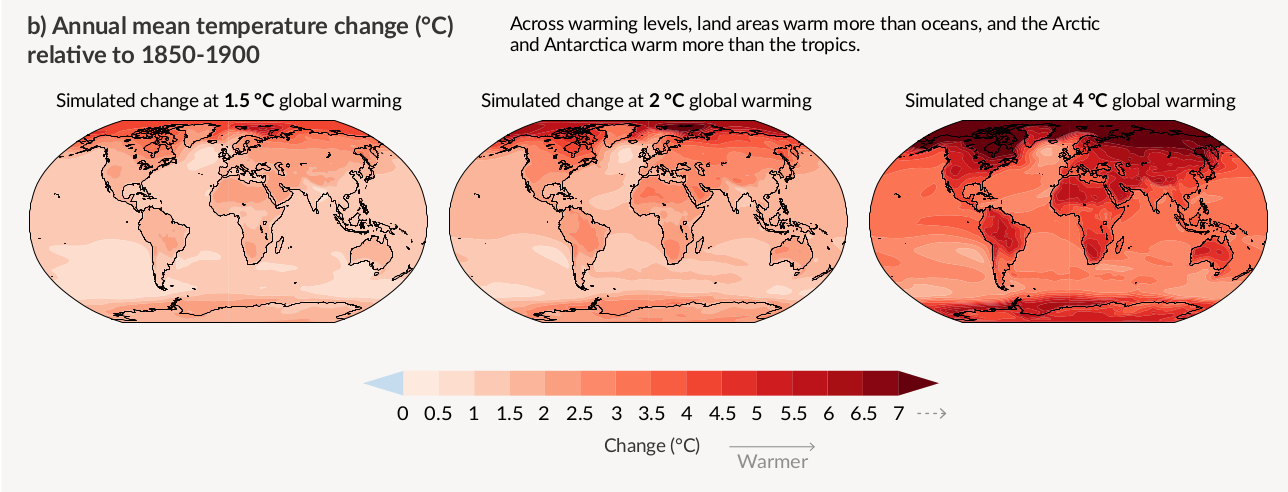

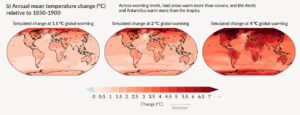
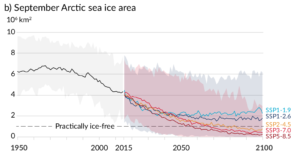

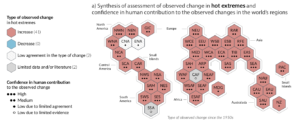
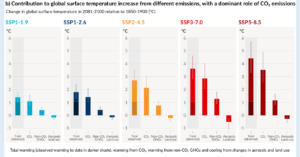
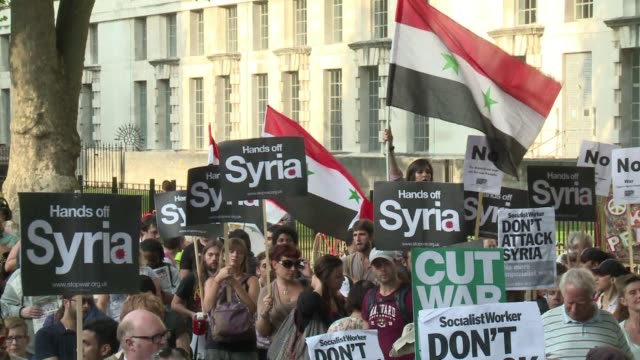
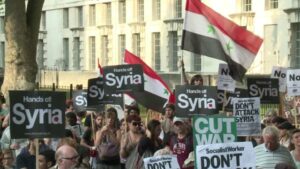
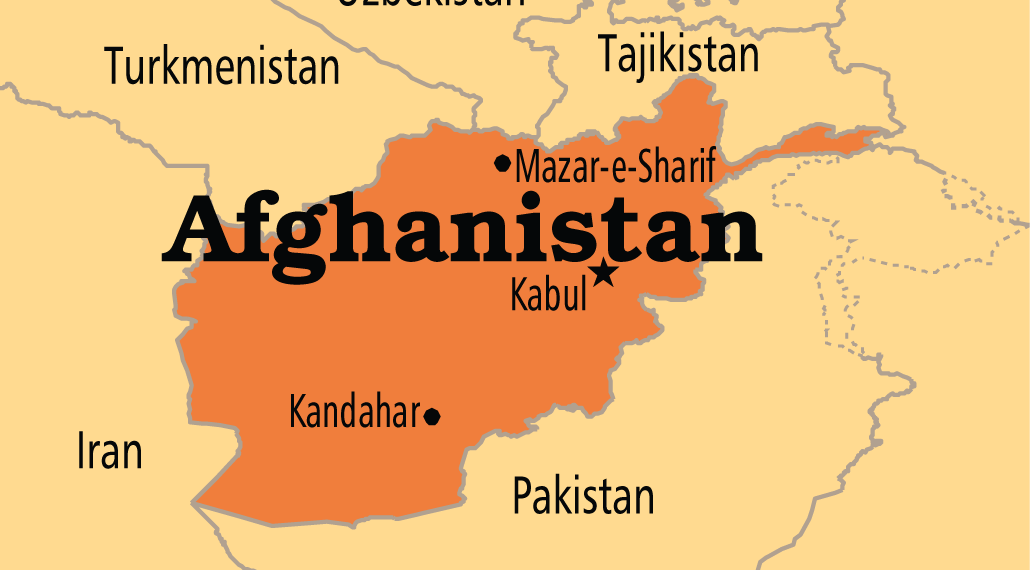
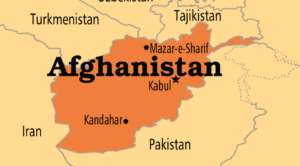 U.S. President Joe Biden invoked Afghanistan’s historical nickname as “graveyard of empires” in order to justify his decision to speed up the withdrawal of American troops from this poor country. He was thus asserting that attempts at securing control over Afghanistan are doomed to fail, while laying the blame on the Afghan government that had been established by the U.S. occupation itself. The tragic pictures of the Afghan government’s collapse along with its state and the panic that got hold of a big fraction of Afghan society, especially in urban areas and above all in the capital Kabul, led to reactions split between two opposite poles: while one pole blamed Biden for having misjudged the situation and having failed to do what should have been done to make sure that the Afghan pro-Western government carries on, the other pole rejoiced and celebrated the magnitude of the defeat suffered by U.S. designs, comparing what took place in Kabul these last days to what happened in Saigon, South Vietnam’s capital, when it was taken over by Communist forces in 1975, two years after the U.S. troops’ withdrawal. It is difficult to decide which of these two reactions is more short-sighted; they both ignore basic facts.
U.S. President Joe Biden invoked Afghanistan’s historical nickname as “graveyard of empires” in order to justify his decision to speed up the withdrawal of American troops from this poor country. He was thus asserting that attempts at securing control over Afghanistan are doomed to fail, while laying the blame on the Afghan government that had been established by the U.S. occupation itself. The tragic pictures of the Afghan government’s collapse along with its state and the panic that got hold of a big fraction of Afghan society, especially in urban areas and above all in the capital Kabul, led to reactions split between two opposite poles: while one pole blamed Biden for having misjudged the situation and having failed to do what should have been done to make sure that the Afghan pro-Western government carries on, the other pole rejoiced and celebrated the magnitude of the defeat suffered by U.S. designs, comparing what took place in Kabul these last days to what happened in Saigon, South Vietnam’s capital, when it was taken over by Communist forces in 1975, two years after the U.S. troops’ withdrawal. It is difficult to decide which of these two reactions is more short-sighted; they both ignore basic facts.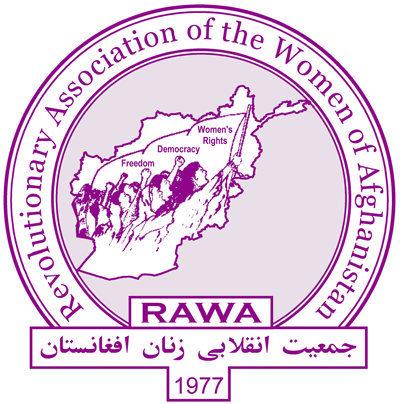
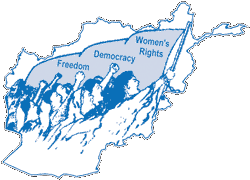
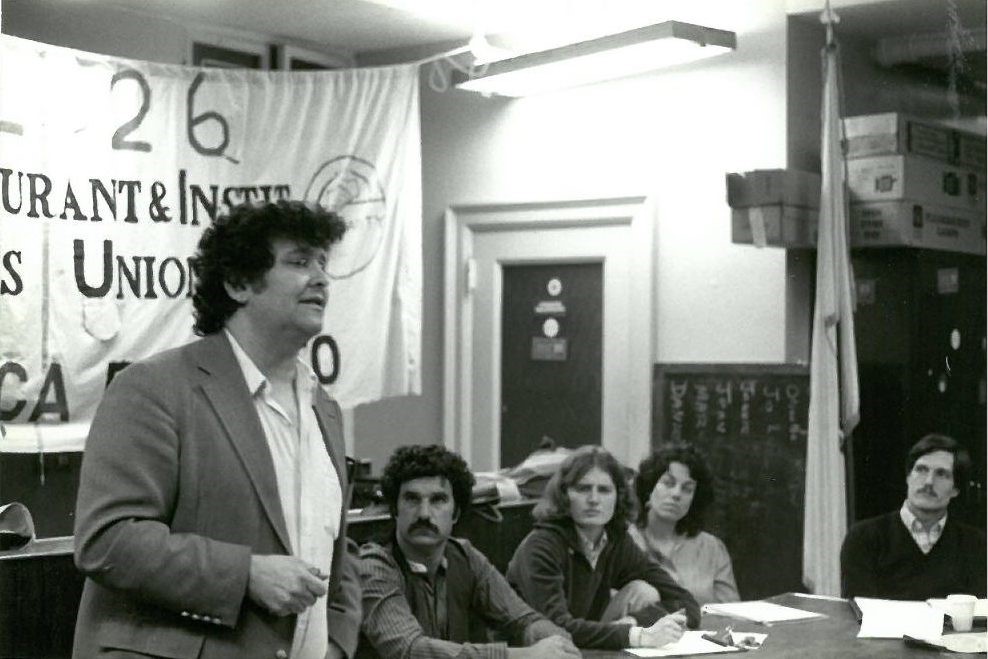
 [Stanley Aronowitz, who died at age 88 in mid August, was to the many on the left who knew and deeply respected him Gramsci’s quintessential organic intellectual. Articulate in prose and breathtaking as a speaker, he was an experienced trade union organizer, prolific author on working-class life, and an academic of the first rank who was himself, as a tenured sociologist at the City University of New York Graduate School, well aware of the limitations incurred by the odious and arbitrary divisions of the social sciences as well as the limitations of contract unionism and its eliding of the capacity for workers to control their own unions, let alone their workplaces.
[Stanley Aronowitz, who died at age 88 in mid August, was to the many on the left who knew and deeply respected him Gramsci’s quintessential organic intellectual. Articulate in prose and breathtaking as a speaker, he was an experienced trade union organizer, prolific author on working-class life, and an academic of the first rank who was himself, as a tenured sociologist at the City University of New York Graduate School, well aware of the limitations incurred by the odious and arbitrary divisions of the social sciences as well as the limitations of contract unionism and its eliding of the capacity for workers to control their own unions, let alone their workplaces. 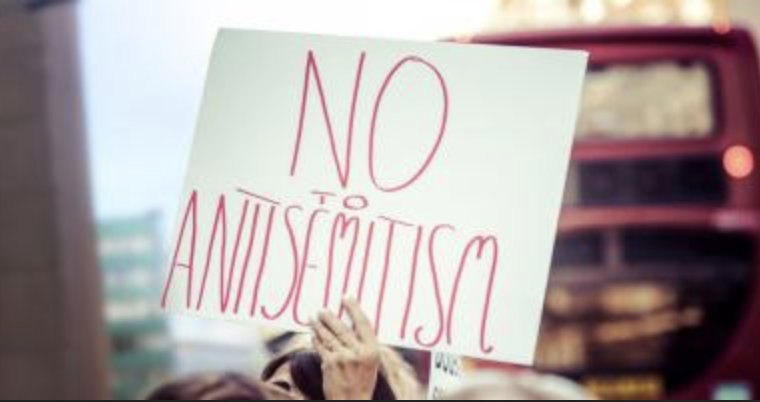
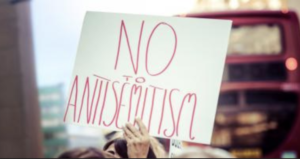 Four months ago, 200 academics from the United States, Britain, Europe and Israel published the “
Four months ago, 200 academics from the United States, Britain, Europe and Israel published the “

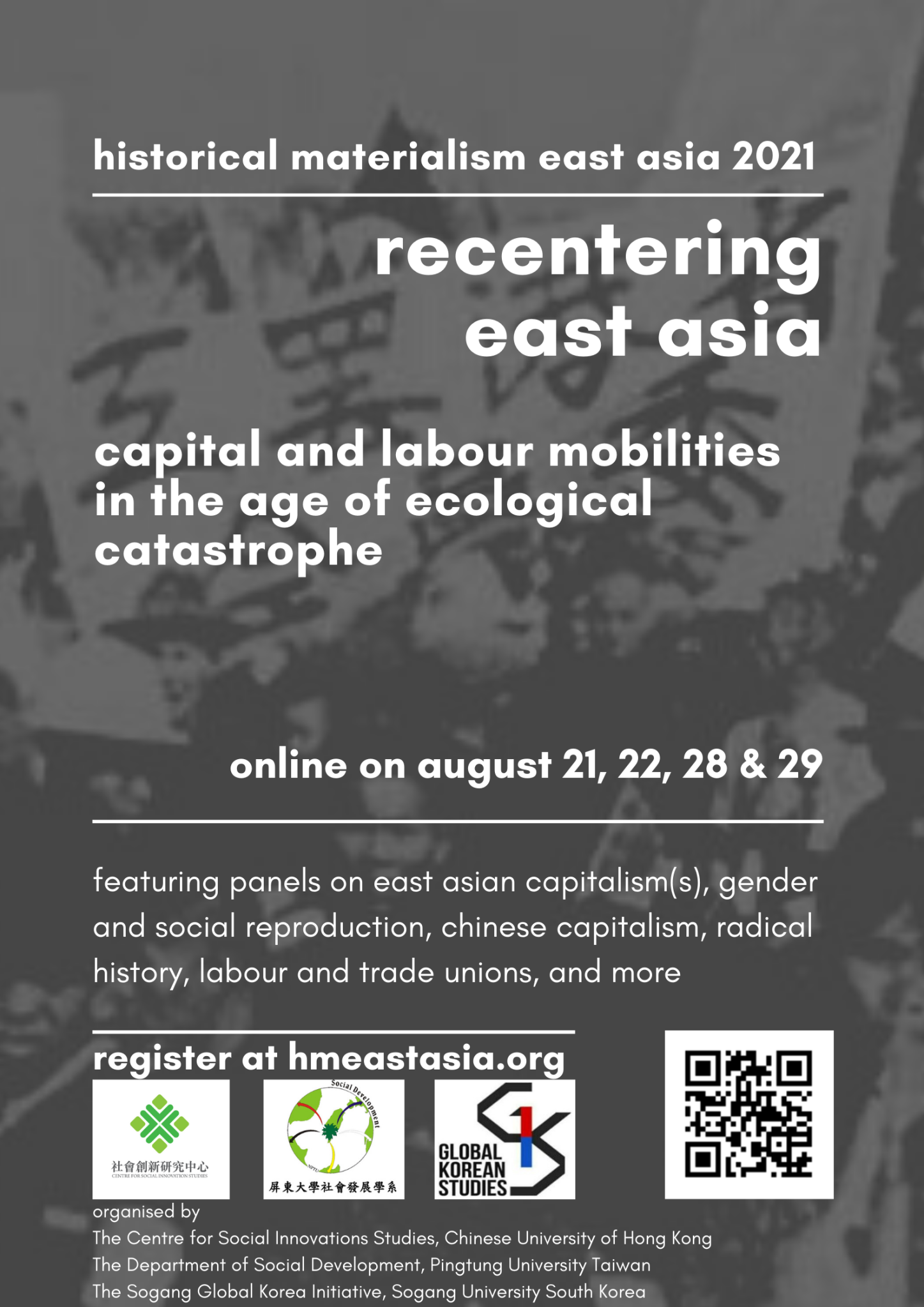
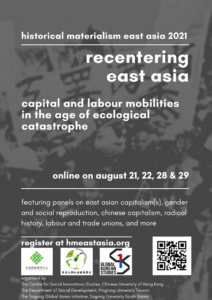
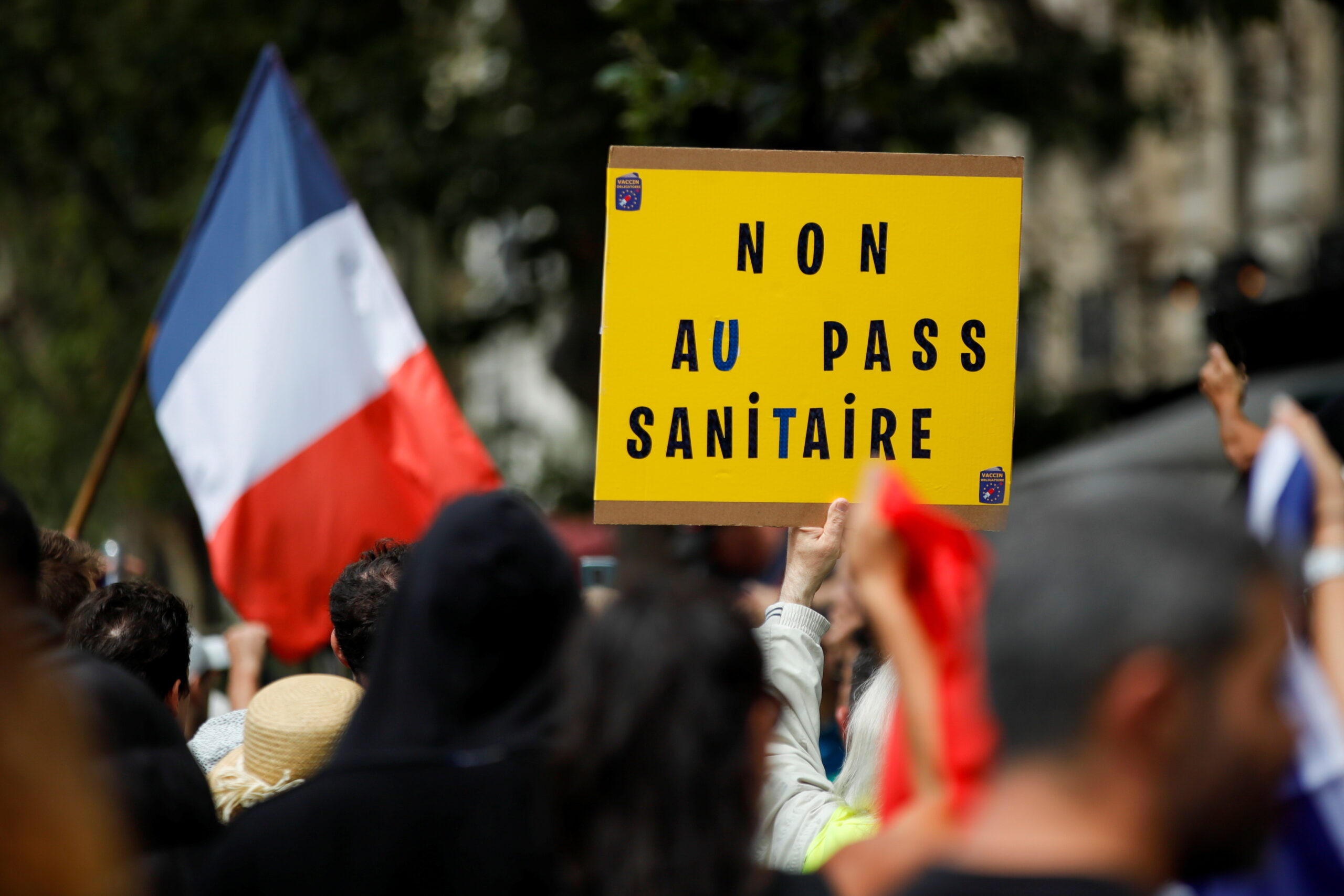
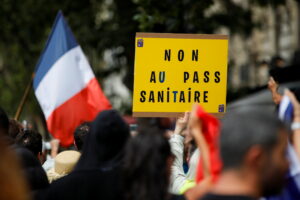
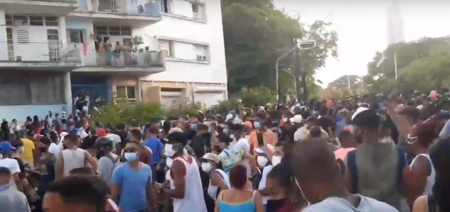
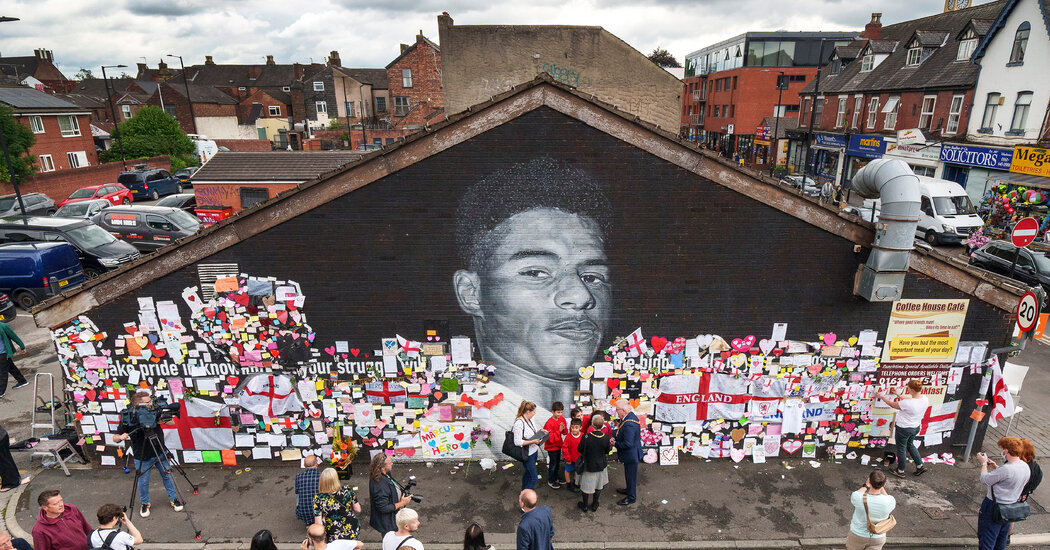
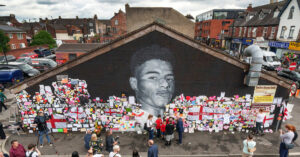 July’s Euro 2020 international men’s soccer tournament was meant to end in glory for Britain’s Tories. The England team reached the final, and were poised to win their first major international trophy since 1966, to set off an outpouring of national euphoria – and help to secure the 2030 men’s World Cup for Britain.
July’s Euro 2020 international men’s soccer tournament was meant to end in glory for Britain’s Tories. The England team reached the final, and were poised to win their first major international trophy since 1966, to set off an outpouring of national euphoria – and help to secure the 2030 men’s World Cup for Britain.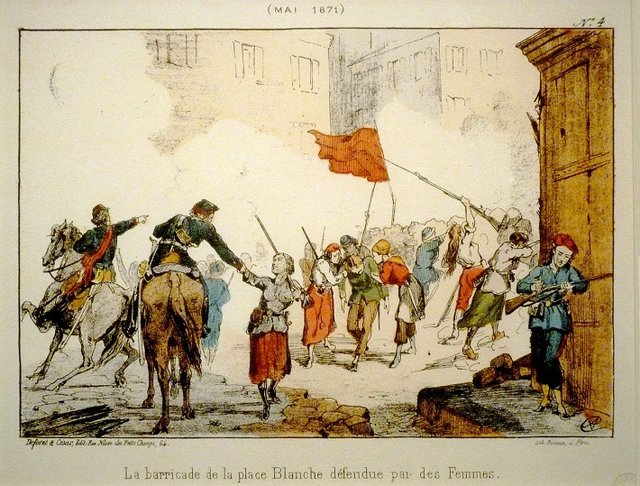
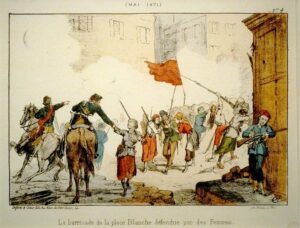
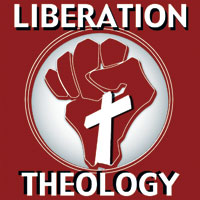
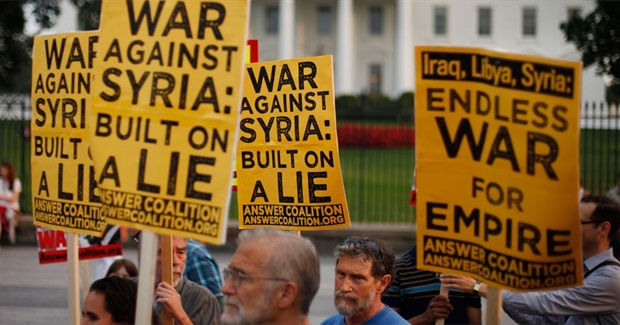
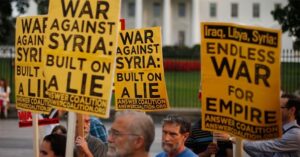
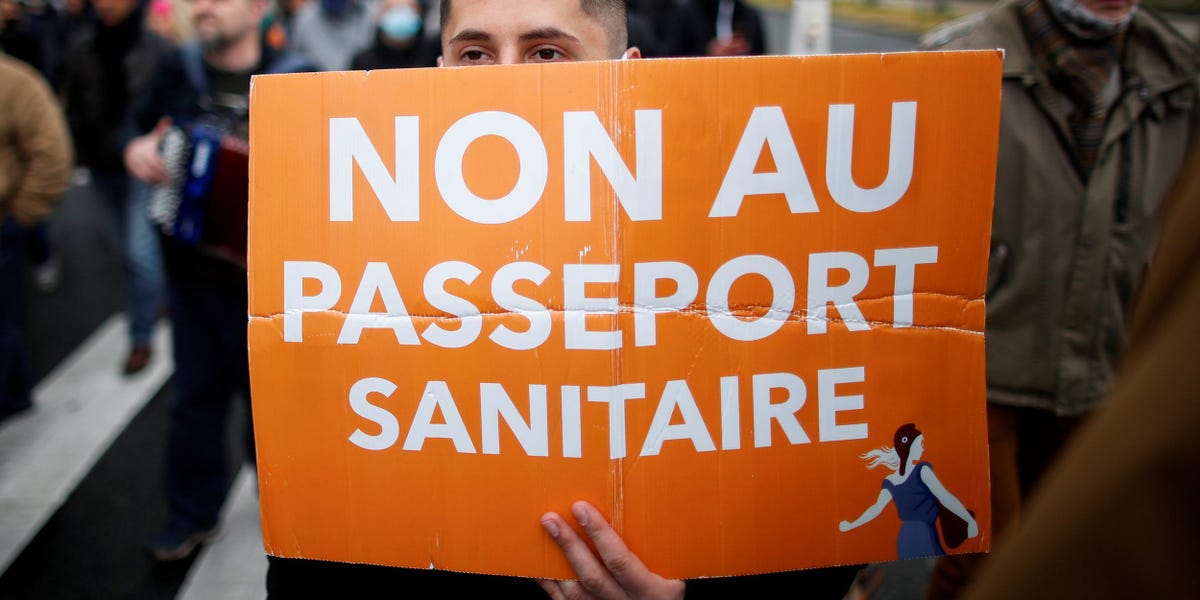
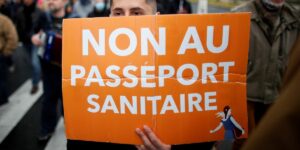 At least 150,000 French people in cities large and small throughout the country demonstrated on July 24, an extremely large number given that July and August and months in which demonstrations never take place because most French people go on vacation. To get an overview of the size and scope watch this video of the demonstrations: click
At least 150,000 French people in cities large and small throughout the country demonstrated on July 24, an extremely large number given that July and August and months in which demonstrations never take place because most French people go on vacation. To get an overview of the size and scope watch this video of the demonstrations: click 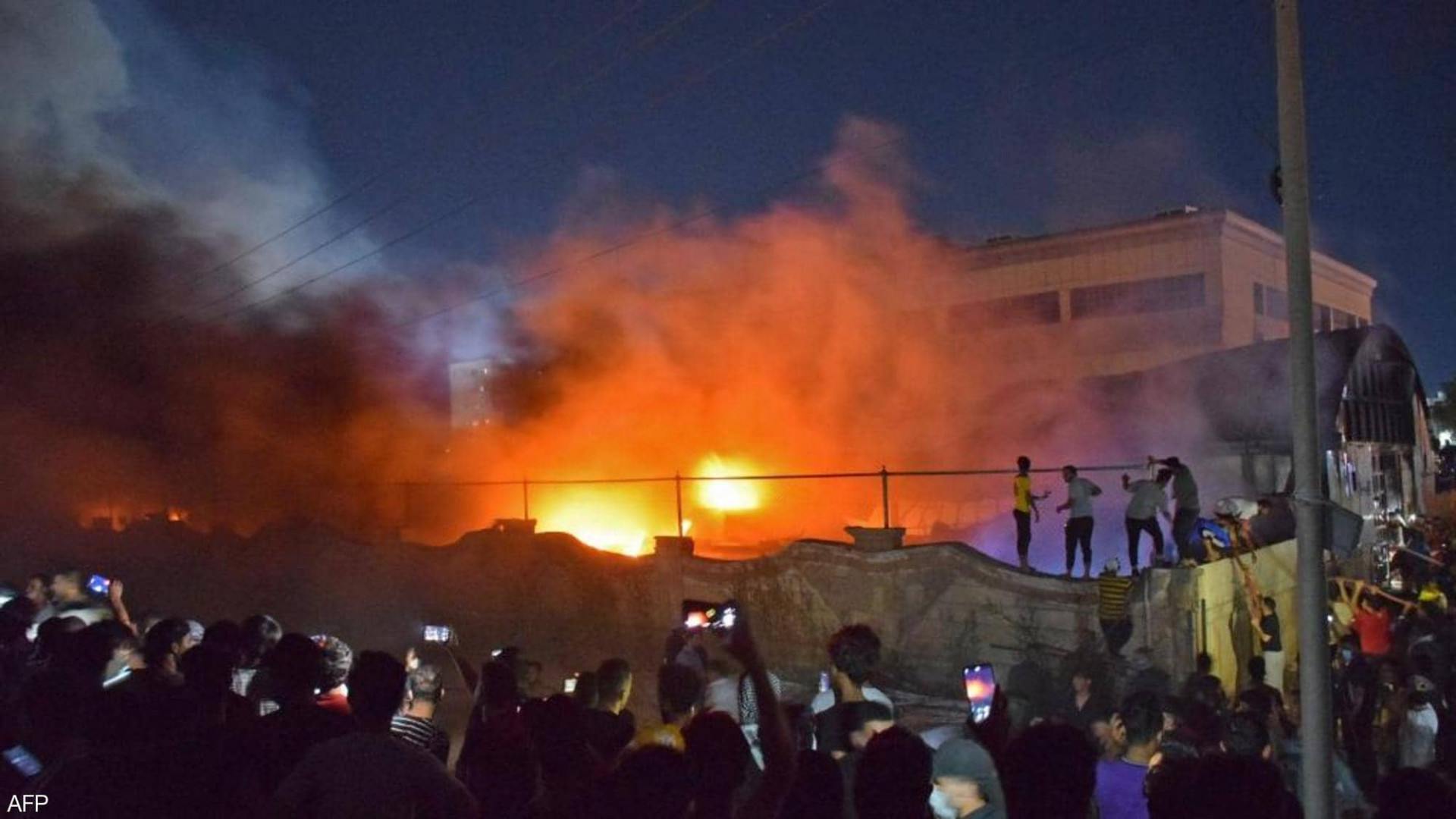
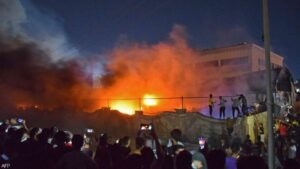 Iran is experiencing another wave of mass protests and strikes as economic, social, political, environmental and health problems make it impossible for the large majority of the population to have the bare minimums needed to live.
Iran is experiencing another wave of mass protests and strikes as economic, social, political, environmental and health problems make it impossible for the large majority of the population to have the bare minimums needed to live.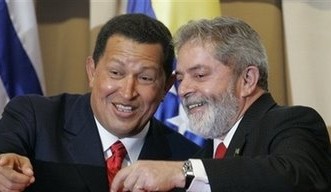
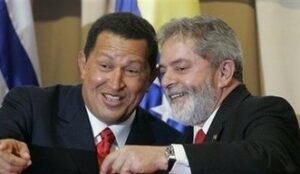
 The Brazilian Workers Party
The Brazilian Workers Party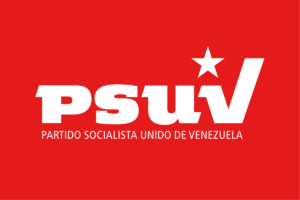 Venezuela’s United Socialist Party
Venezuela’s United Socialist Party
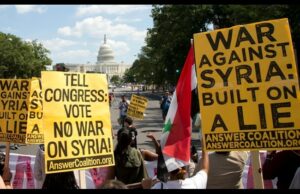
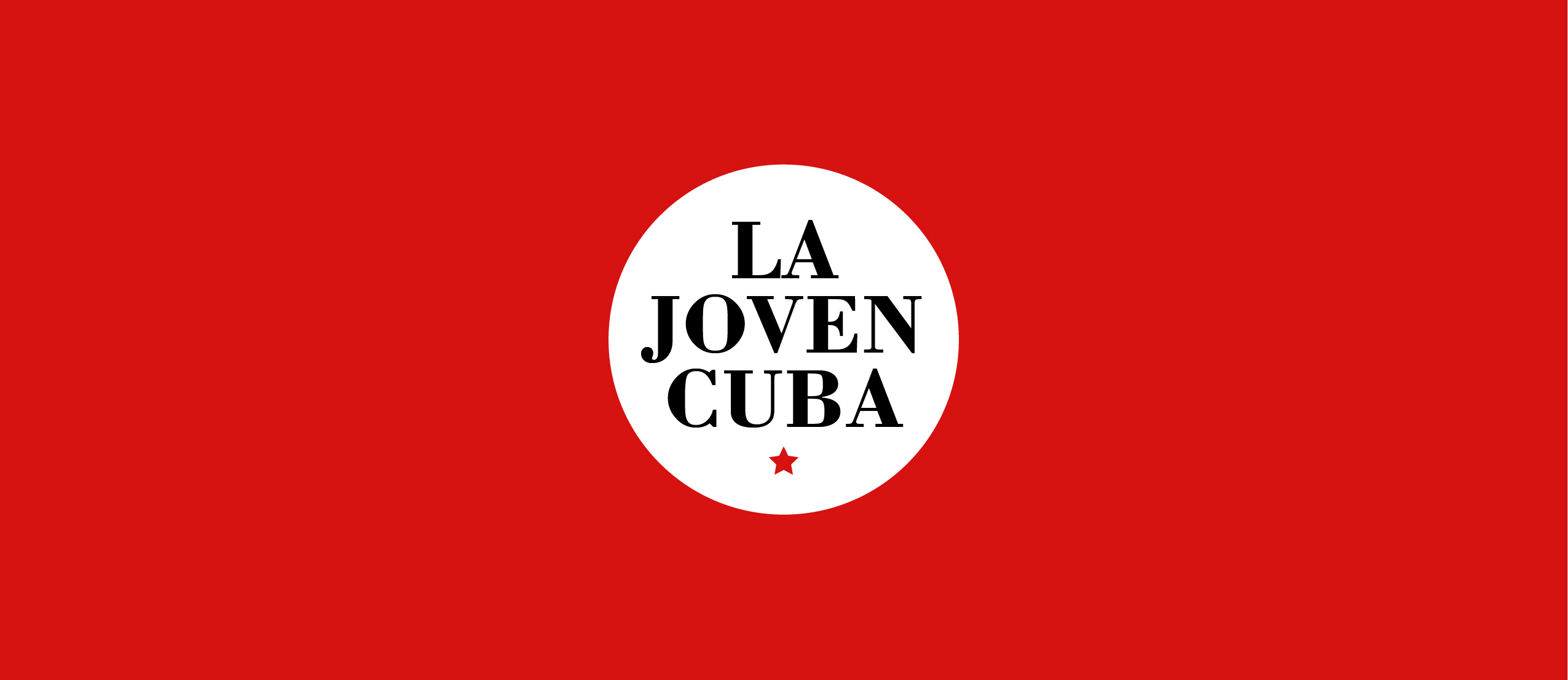
 Alina Barbara López Hernández is a historian, university professor and a friend. Her contributions to La Joven Cuba, one of the most important blogs in the island have been enormous because of her intelligence, political culture, integrity, and courage in the face of a difficult political situation. – Samuel Farber
Alina Barbara López Hernández is a historian, university professor and a friend. Her contributions to La Joven Cuba, one of the most important blogs in the island have been enormous because of her intelligence, political culture, integrity, and courage in the face of a difficult political situation. – Samuel Farber
